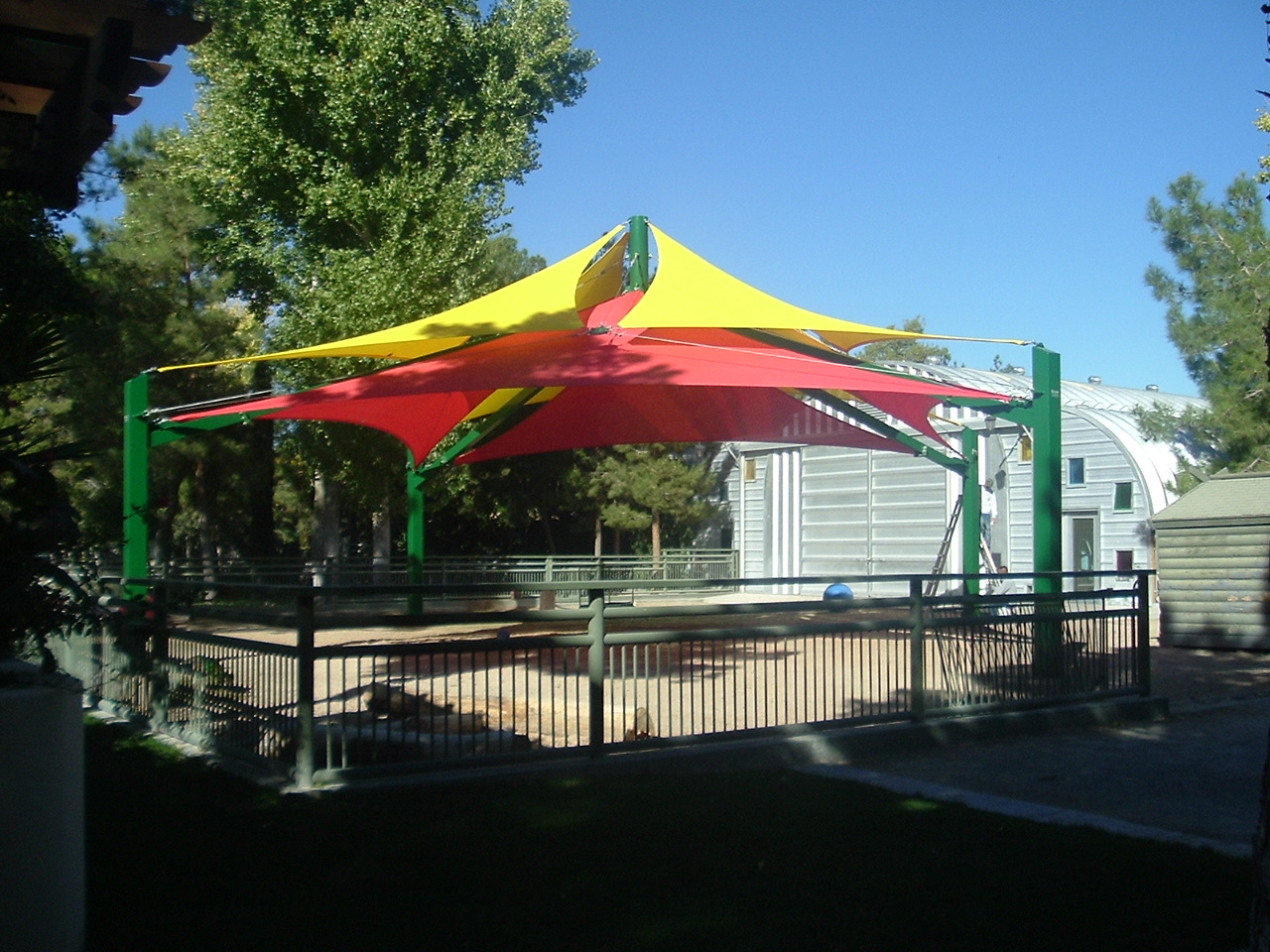The success of any farm relies on its surrounding environment. By practicing thoughtful and sustainable farming methods, you can preserve the land you farm on while protecting the surrounding ecosystem and contributing to a healthier planet. When you make changes now to become an eco-friendly farm, your farm can improve long-term productivity and efficiency, as well.
How do you become an eco-friendly farm? Though it’s a long process that requires time and effort, converting your farm to one that prioritizes sustainability can help you produce more products, prioritize your farmworkers and save money in the long run. There are numerous steps you can to turn your agricultural operation into a greener business.
Continue reading for more information on what an eco-friendly farm is, why it’s important to pursue sustainability as a farm and how you can adopt more eco-friendly farming techniques.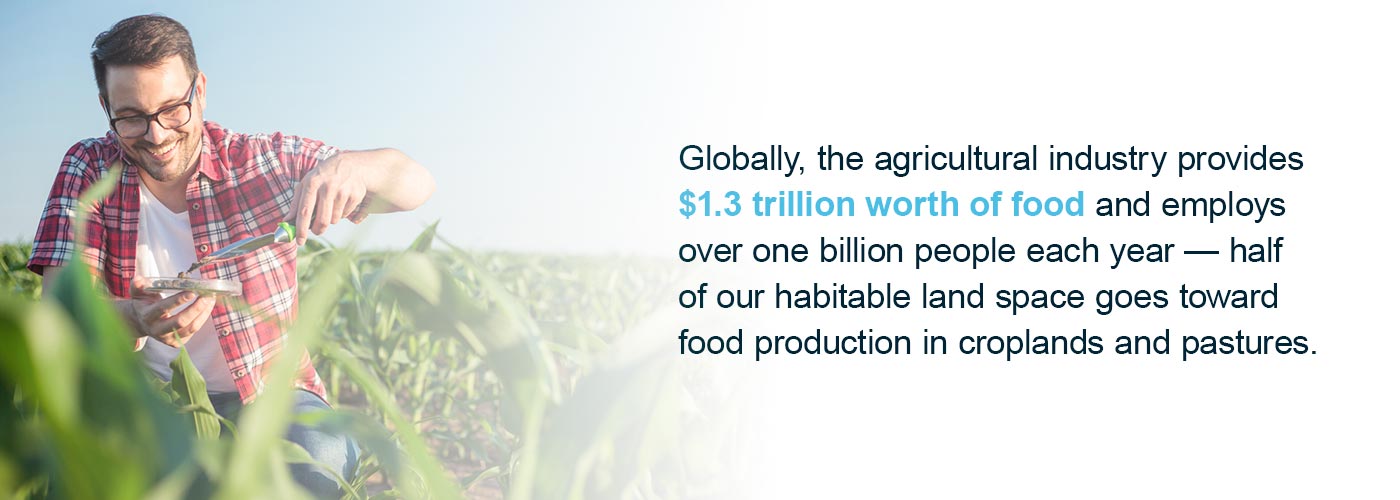

What Does It Mean to Have an Eco-Friendly Farm?
Globally, the agricultural industry provides $1.3 trillion worth of food and employs over one billion people each year — half of our habitable land space goes toward food production in croplands and pastures.
To feed a hungry world, farmers may use solutions that briefly ensure crop production, such as using chemical fertilizers or washing away topsoil from inefficient irrigation. These methods don’t protect the land for long-term use, and the negative effects of modern agricultural practices contribute to pollution, soil depletion, poor working conditions for farmworkers, higher production costs, excessive water consumption and declining harvests.
Having an eco-friendly farm means you need to switch from certain modern farming strategies to techniques that consider the long-term effects of agriculture on the land and its resources. Consider how your farming approach affects the soil, water and pollution in the area. If you employ farmworkers, think about how you can help improve their working environment on your farm and train them in sustainable practices in agriculture.
When you change your farming practices to work toward sustainability, you preserve the future of your farm and contribute to a healthier planet.
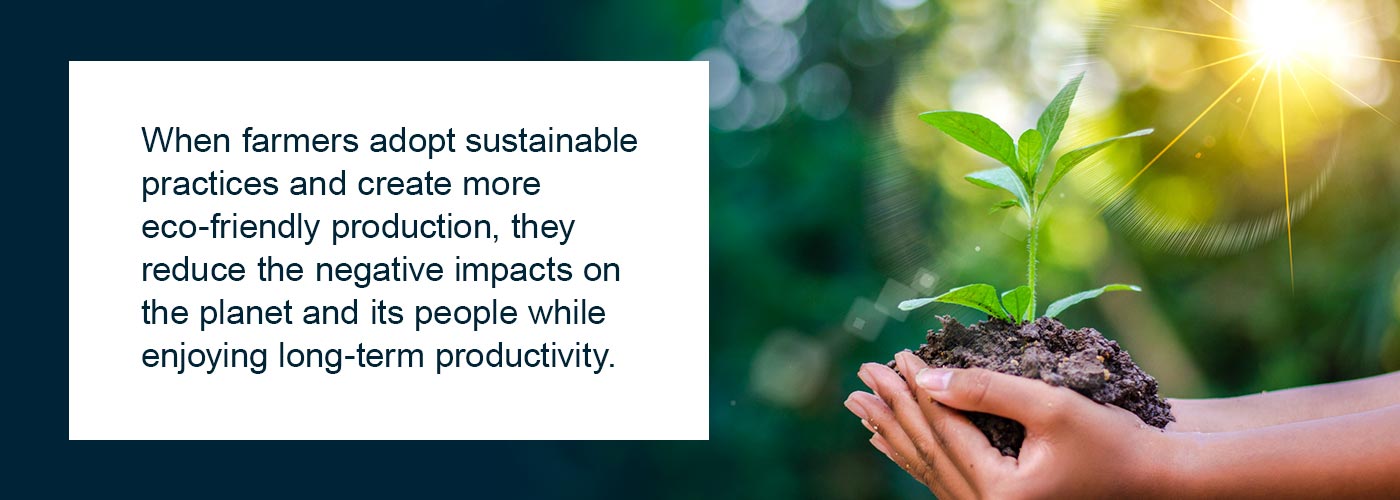

11 Steps to Achieve Eco-Friendly Farming
When farmers adopt sustainable practices and create more eco-friendly production, they reduce the negative impacts on the planet and its people while enjoying long-term productivity. Turn your farm into an environmentally friendlier operation by integrating some of the following changes:
1. Recycle Plastic Waste
Depending on their production levels and size, plastic creates a significant source of waste on farms. A few agricultural plastics include:
- High-density polyethylene (HDPE): Commonly found in plastic nursery pots and pesticide containers
- Low-density polyethylene (LDPE): Typically found in flexible products, such as bale wrap, greenhouse covers, haylage or silage bags, silo covers and mulch bags
- Polypropylene (PP): Used for the construction of tarps, nursery pots and row covers
- Polystyrene (PS): Durable, rigid material found in nursery flats, pots and other containers
Disposing of these products can be difficult. Some farmers burn them, but doing so releases furans and dioxins into the air, which contribute to pollution, harm human and animal health and can contaminate water and soil. Alternatively, farmers may toss these plastics into landfills, but a better option exists in many communities.
The nonprofit Ag Container Recycling Council (ACRC) heads a national effort to reduce HDPE plastic waste in landfills by offering recycling programs around the country. Each year, the organization collects and recycles 11 million pounds of HDPE from agriculture chemical containers. After recycling, the waste can be turned into other agricultural products, such as nursery pots, landscape edging, drain pipes, industrial pallets, fence posts and cinder blocks.
When you recycle even some of your farm’s plastic waste, you can reduce how much you need to take to a landfill, protecting the environment from toxins and contributing to a growing recycling industry.
2. Choose Efficient Lightbulbs
Switching your lightbulbs from existing incandescent bulbs to energy-efficient light-emitting diodes (LEDs) saves your farm energy use while extending the life span of the bulbs. LEDs use 75% less electricity to produce the same amount of light compared to incandescent bulbs. Additionally, LED lights last up to 30 times longer than incandescent bulbs and up to five times longer than compact fluorescent lights (CFLs).
The reason LEDs are so energy efficient comes from their lack of heat production. Comparatively, incandescent lights waste 90% of their energy in heat production and CFLs release 80% of their energy as heat instead of light. LEDs don’t create heat, making them more efficient and a better option for lighting temperature-sensitive areas of your farm. By upgrading to LED lights, you’ll invest in lighting that will last much longer and use less electricity.
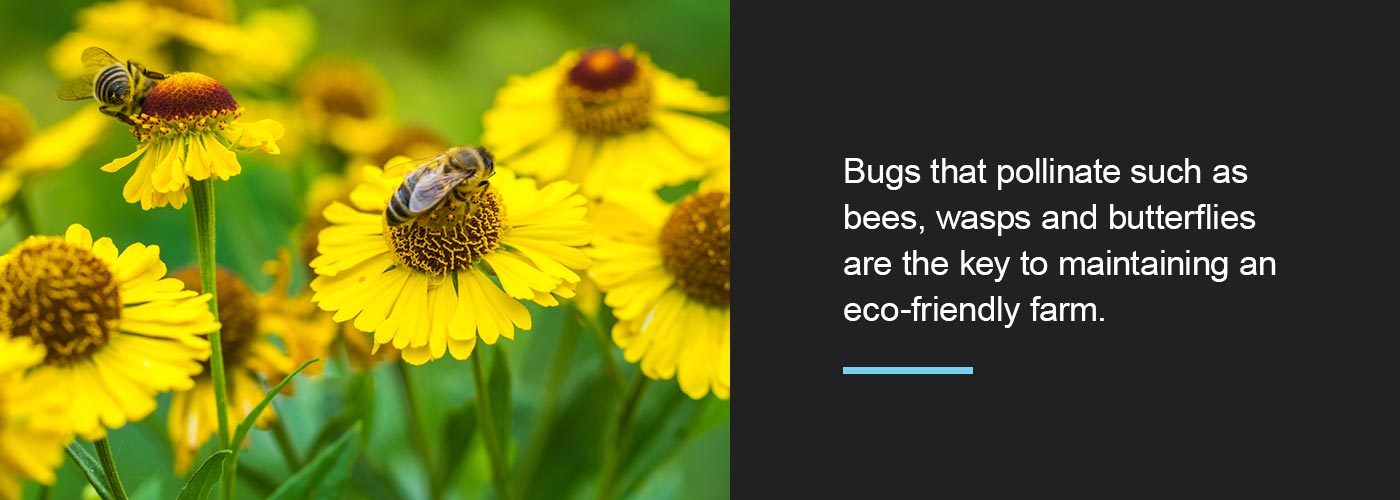

3. Support Pollinators
Bugs that pollinate such as bees, wasps and butterflies are the key to maintaining an eco-friendly farm. Protect them as much as possible by avoiding using pesticides that can kill them and damage their habitats.
These insects need habitat space and flowers to feed on. In unused areas of your farm, plant popular flowers for them based on your region. These flowers encourage bees and other pollinating insects to visit your farm, where they can pollinate your plants and encourage natural growth.
If you have the ability to set up hives on your farm, you benefit from the honey the bees produce, too. It’s a sweet reward for helping your farm and the local ecosystem.
4. Get Rid of Expired Pesticides and Herbicides
Expired agricultural chemicals may not work properly, and keeping outdated pesticides and herbicides on your property presents an environmental hazard. Leaks in containers could cause the products to contaminate the soil and groundwater. Check with your local agriculture extension to see if there’s a safe agriculture chemical disposal program in your area.
5. Reduce Tilling the Soil
Decreasing soil tillage could positively impact the environment. Because soil traps carbon in the form of soil organic carbon (SOC), regular tilling of the soil releases SOC into the atmosphere. As a solution, organic farming raises the SOC stocks naturally while improving overall soil health.
In a study of European farms, researchers compared SOC stocks on organic farms with reduced tillage increased by 1.7% and 3.6% to farms with standard tilling. The study concluded that using reduced tillage has the potential for raising stocks of SOC when paired with organic farming practices, protecting the atmosphere from excessive carbon releases from the soil.
6. Rotate Crops
Instead of planting the same crops on the same plot of land year after year, change what you grow and where. When you change crop positions, you’ll have fewer problems with pests that favor one type of plant. Additionally, you improve the health of your soil, especially if you plant nitrogen-fixing crops, such as legumes.
One study found that starting a plot with velvet beans and switching to maize later in the season produced up to 100% greater maize yields compared to a plot that only grew maize. Additionally, the plots with legumes and their residue incorporated into the soil rotated with maize could reduce or eliminate the need for additional nitrogen fertilizer.
When planning the products you want to grow for the season, be sure to incorporate a method to rotate each crop properly.
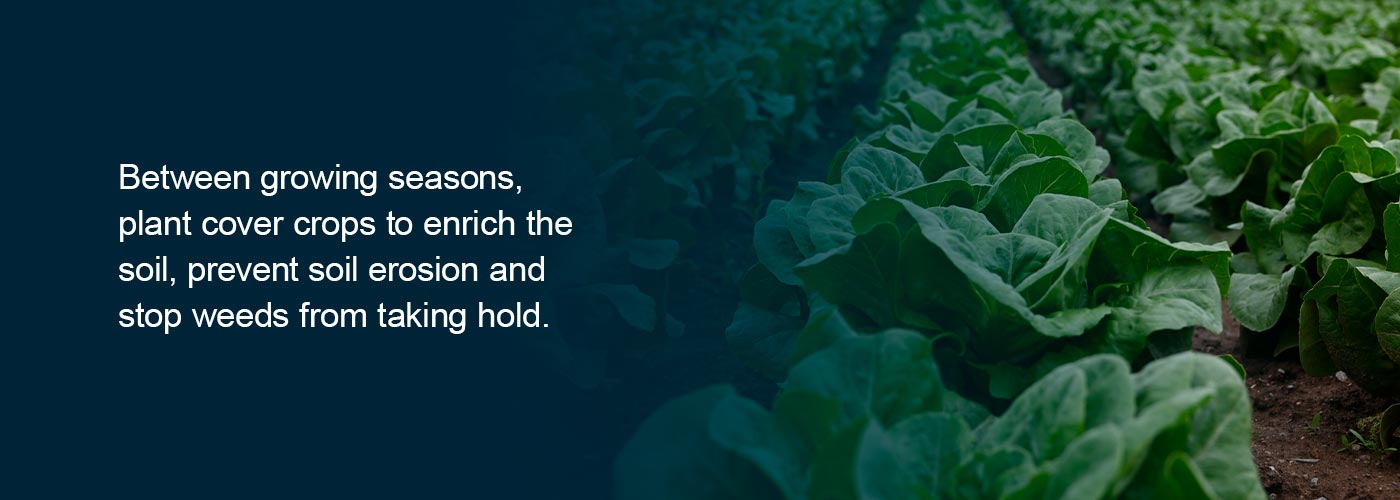

7. Plant Cover Crops to Protect Soil in the Off-Season
Between growing seasons, plant cover crops to enrich the soil, prevent soil erosion and stop weeds from taking hold. Depending on your cover crops, you could even save the cost of buying haylage for livestock and letting the animals graze on the cover crops.
8. Use Shade Structures to Protect Workers and Plants
Installing shade structures can help make your farm more sustainable by protecting workers from the intense heat of the sun. The covered areas are more comfortable to work in, which could increase your workers’ productivity and improve their working environment.
Additionally, your plants benefit from shade structures by keeping direct sunlight away from seedlings and other delicate plants or plants that require partial sun or shade for growth. Only use shade structures with breathable materials to ensure adequate airflow that keeps the shaded area from becoming stagnant.
9. Switch to Low-Pressure, Efficient Irrigation
Use low-pressure dribble irrigation systems to reduce water waste. These systems drip smaller amounts of water into the soil instead of spraying them over the crops — water spray evaporates readily, especially when irrigating during the hottest part of the day. In comparison, drip systems use less energy for irrigation and lose less water through evaporation by not spraying the water over crops.
10. Consider Alternative Growing Methods
Some alternative growing methods may help your farm increase yields:
- Both aquaponics and hydroponics deliver nutrients directly to plant roots via nutrient-dense water instead of soil.
- Permaculture replicates natural ecosystems within a farm to reduce the need for extra resources, improve yields and create more sustainable farming.
- Agroforestry, similar to permaculture, replicates natural habitats on a farm but uses a forest ecosystem for its model.
These methods can create sustainable growing methods, depending on what your farm produces and its location.
11. Choose Renewable Energy Sources
For centuries, wind and running water from rivers have been sources of energy to power windmills and watermills for grinding grain. Bring back the use of these or other renewable energy sources on your farm to make your operation more sustainable. For instance, install solar panels to generate electricity to operate heating or pumping systems.
The Value of Eco-Friendly Farming
Choosing eco-friendly farming is good for your bottom line, your farmworkers and the environment. The following are only a few of the numerous benefits your farm and the world can gain from sustainable agriculture and eco-friendly farms:


1. Improve Production Over Time
Environmentally friendly farming allows you to maintain or improve production with less waste and energy. Over the long term, farms that use sustainable practices have greater chances of maintaining production levels by protecting the soil from erosion and using water resources properly.
For example, diversified farms that use crop rotation have protection from weeds and pests that impact single-crop farms. Additionally, cover crops protect and enrich the soil.
2. Reduce Costs
Sustainable farms use less energy, less water and fewer herbicides and pesticides. Cutting back on these resources saves your farm money, allowing you to invest more into further improving your farm’s sustainability. The amount of money you save depends on how much you reduce waste and resource use on your farm — more reductions provide improved savings.
More energy-efficient lights and the use of sustainable energy also reduce your reliance on electricity you must purchase to keep your farm running. These savings further decrease your expenditures and raises your profit margins.
3. Decrease Waste
Farming naturally produces waste in a variety of forms, from organic to inorganic. The amount of waste your farm produces and how you handle it can impact the amount of time and money spent on waste handling. Eco-friendly farming cuts back on this waste. For example, when you choose to recycle HDPE or other agricultural plastics, you decrease the amount of waste that ends up in a landfill.
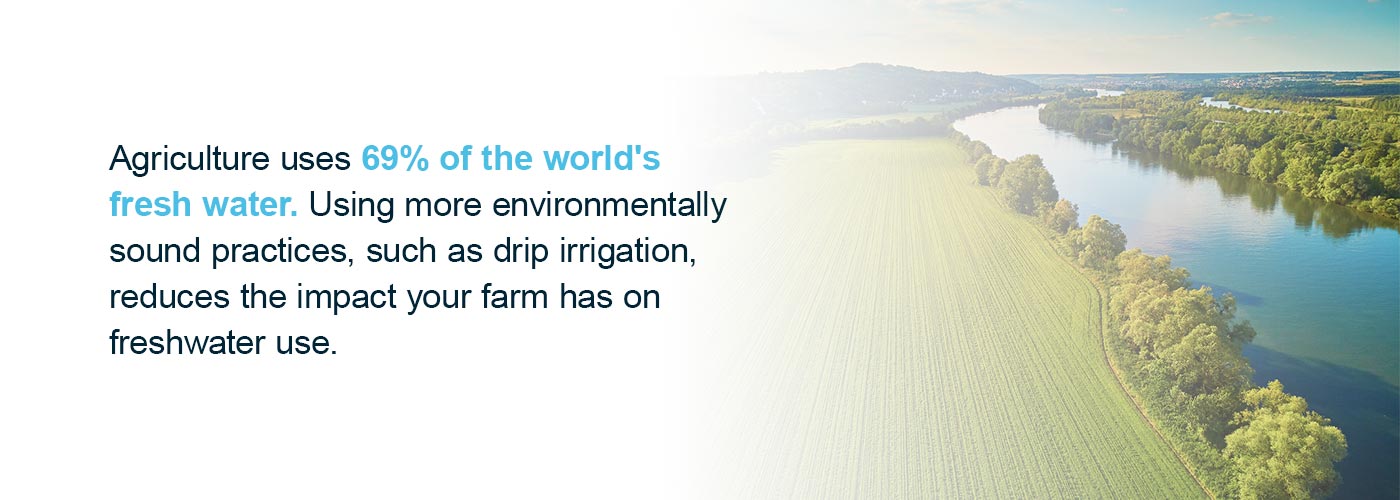

4. Protect Environmental Resources
Agriculture uses 69% of the world’s fresh water. Using more environmentally sound practices, such as drip irrigation, reduces the impact your farm has on freshwater use. Combining better water management with soil protection practices, such as reduced tillage, can also preserve soil nutrients while reducing erosion and the need for fertilizers. Less tillage reduces carbon releases into the atmosphere, helping reduce negative impacts on the planet’s atmosphere.
When your farm makes better use of environmental resources, the planet and your farm benefit by protecting these vital assets for future farming generations.
5. Prevent Pollution
Reducing waste is only one way of preventing pollution. When your farm converts to more environmentally friendly operations, you cut down on the total pollution you generate.
By recycling containers instead of burning them with trash, you reduce air pollution. Cutting down on soil tilling reduces carbon released into the atmosphere. Plus, you reduce the emissions produced by engine-powered tillers since you don’t use them as much. Crop rotations that let you cut down on fertilizer help prevent water pollution caused by runoff of fertilizers from the soil. Drip irrigation also reduces water waste and runoff pollution.
Sustainable agriculture cuts down on pollution and waste, reducing impacts on the environment.
6. Prevent Future Hunger
With a projected global population of 9 billion people by 2050, world agriculture will need to increase production by 70% and improve the distribution of produced food and resources to prevent future hunger. Using sustainable practices will reduce the resources farms today and protect the land and water use for the future. By being environmentally friendly, farms can help to preserve resources needed to feed a future world and prevent hunger in later generations.
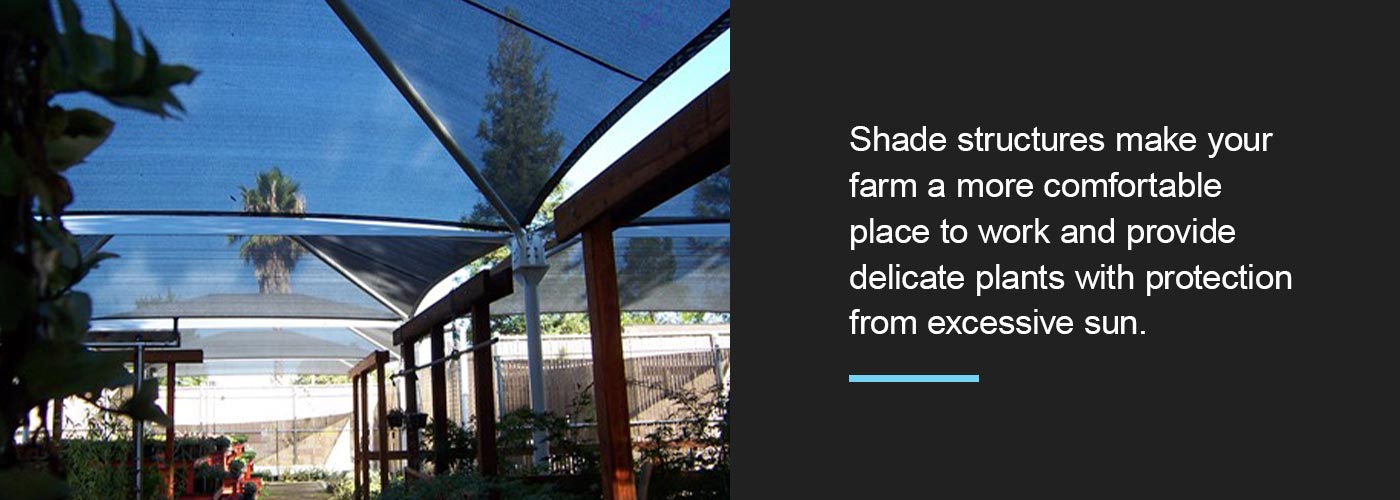

Shade Structures for Farms
Shade structures make your farm a more comfortable place to work and provide delicate plants with protection from excessive sun. Their many designs allow you to use them for practical and aesthetic reasons. The following are commonly used shade structures for greenhouses and other agricultural sites:
Rectangular and Square Structures
The most budget-friendly option, rectangular and square shade structures fulfill a variety of shade needs on farms. Rectangular and square shapes fit perfectly over nursery rows of plants, particularly those you’re growing to encourage the presence of pollinating insects. They also offer shade over working areas or walkways to keep people protected from the sun. Options for different colors and roof designs give you flexibility when choosing the perfect shade structures for your farm.
Cantilever Structures
Cantilever shade structures only require one or two support posts. These structures work best when used in areas that don’t have enough space for full four-post structures or where the extra posts would get in the way. These types of structures are ideal for creating cooling areas for farmworkers to sit out of direct sunlight during the day. These structures can also work in greenhouses or for parking areas.
If you have only a handful of parking spots or need areas for vehicles to drive up to an area for loading, you can cover the space with a cantilever shade structure. The use of support posts on one side ensures maximum space under the structure for parking or loading a vehicle. Larger cantilever structures can protect several vehicle spaces or walkways from sun exposure and the increased heat caused by direct sun.
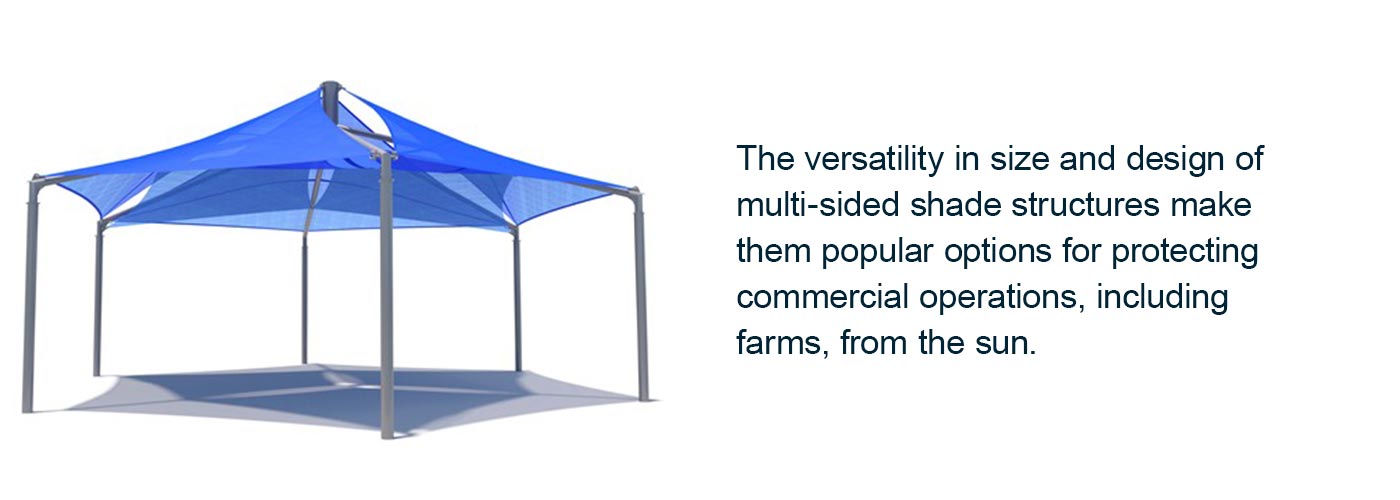

Multi-Sided Shade Structures
Multi-sided shade structures come in many shapes, from hexagons to octagons. Unusual shapes such as triangular structures or five-point sails add a modern look to any space. Your farm may benefit from the appealing style these structures offer, especially if you have consumers visit your farm for tours, to buy produce or for pick-your-own purchases.
These designs protect large areas up to 60 feet across. If the options for rectangular structures are too small, you may find the coverage you need from a multi-sided design. Smaller formats, such as hexagonal or octagonal designs on single posts, work well for picnic areas, farmworker rest sites or around your greenhouses.
The versatility in size and design of multi-sided shade structures make them popular options for protecting commercial operations, including farms, from the sun.
Customized Designs
Your farm may have a specific layout that standard shade structure designs don’t fit. Customized options give you the freedom to designate the style of shade cover, the coverage area, coloring, material and much more.
For your farm, customized shade structures give you sun protection over unusually shaped spaces or create an eye-catching design to draw attention to your farm and make it more beautiful.
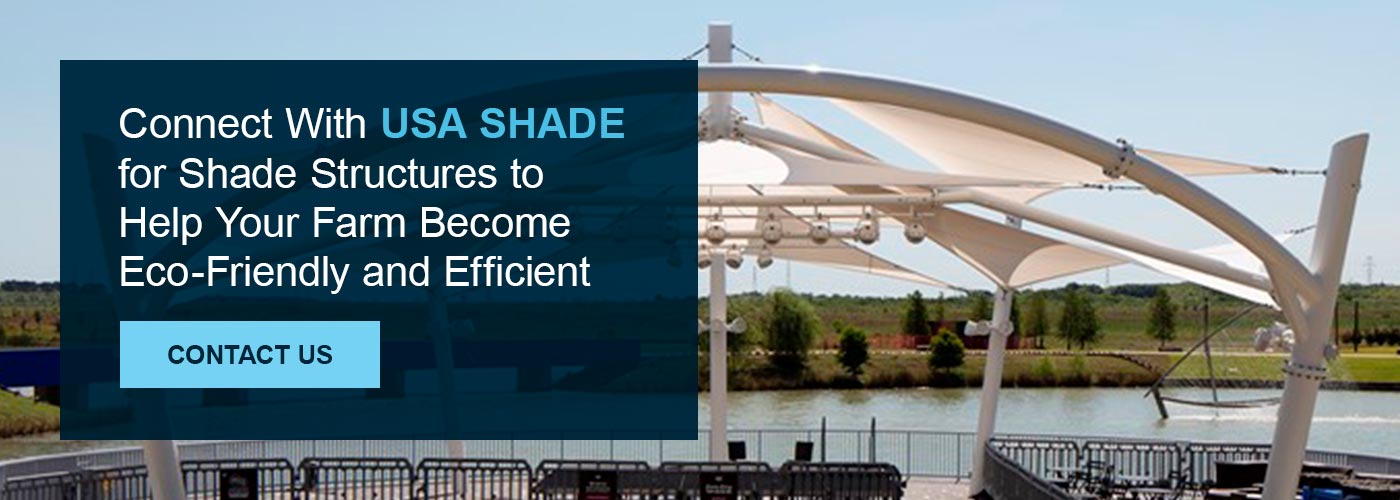

Connect With USA SHADE for Shade Structures to Help Your Farm Become Eco-Friendly and Efficient
Installing shade structures around your farm contributes to a more efficient and eco-friendly facility. Find a variety of permanent shade structure options for gardens and farms from USA SHADE. Whether you’re interested in providing sun coverage for plant growth or want to provide shaded areas for farmworkers, our shade structures can help you meet your farming sustainability goals.
We offer turnkey services at USA SHADE to help your farm obtain the shade structures necessary by providing you with assistance from the design through installation stages. Contact us at USA SHADE to request a quote for permanent shade structures for your farm.


